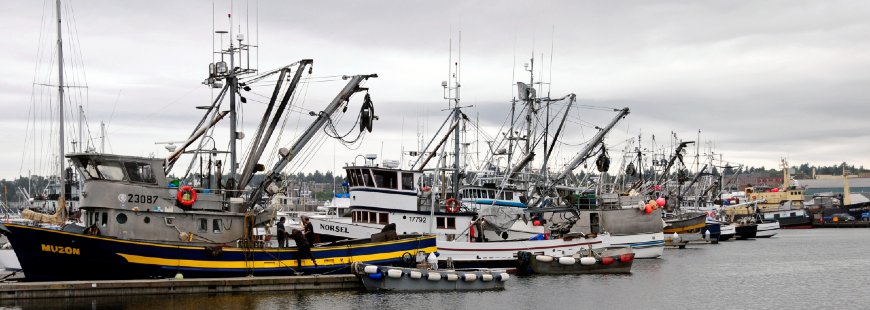Much of the crucial aid distributed to fishing families in response to the COVID-19 emergency this year has been provided using the regulatory machinery from the NOAA fishery disaster program . Forty years ago, Congress included the fishery disaster program in the Magnuson-Stevens Act in order to protect fishing communities from rare and unpredictable environmental events.
Today, rare and unpredictable events are all too common and all too predictable as climate change continues to impact fisheries at a rapid clip. And disseminating disaster aid, pandemic notwithstanding, can take more than three years.
It might just be time for a fishery disaster program overhaul. It could also be time to rethink the fundamental approaches of our safety net for managing risk in fisheries.
The section of the Magnuson-Stevens Act that deals with fishery disaster assistance doesn’t contain any requirements for fishery disaster determinations to be made in a timely manner. It also requires the governor of a state or the representative of a fishing community to request a disaster determination. These omissions slow down the process and add a political element to what should be solely an economic consideration. These issues could be addressed by making disaster determinations an automatic function of NOAA Fisheries and/or by implementing a timeline for disaster determinations.
Additionally, a fishery disaster determination does not guarantee that funding will be delivered. Congress must appropriate fishery disaster funds, and as we have seen in some years in the past, this can pose a major political challenge. Appropriations problems could be addressed by creating a dedicated interest-bearing account at the Treasury to hold onto funds and distribute them as necessary. Funding for such an account could come from the same seafood, ocean products, and aquaculture tariffs that fund the Saltonstall-Kennedy research grant program . Seventy percent of these funds go to the general Treasury pool rather than to programs benefitting fisheries and economic development, so this concept in no way jeopardizes the important S-K research programs that currently exist.
But systematic fixes to the current disaster program can only go so far. 2020 has shown us just how critical quick access to capital is to fishing families during hard times. I believe that there’s a major lesson for the commercial fishing industry to learn from an existing and popular federal program: crop insurance. This might just be the ticket to find new ways to support fishing families.
Currently, the US crop insurance program operates as a subsidized public-private partnership between the federal government and insurance brokers. Unlike the federal fishery disaster program, which some (including fishing industry members themselves) criticize as operating like a handout, crop insurance policyholders pay for an actuarial floor against which they can manage their risk exposure to natural disasters and major price fluctuations. The program operates by heavily subsidizing insurance premiums (up to 80% in most cases) and covering broker fees. The program is fairly prescriptive when it comes to protecting policyholders and determining when payouts must occur. It’s possible that many of the woes betiding fishermen this year could have been addressed in serious and meaningful ways if we had a fisheries insurance program in place.
Envisioning such an insurance program for commercial fisheries is not an easy task. As we all know, the commercial fishing industry is highly specialized, complex, and highly risk-exposed business. And I can’t even begin to contemplate the complexity of the insurance business; I’ll leave that to the professionals. But I do believe that the benefits that could be realized from the development of a subsidized, yield-based insurance program for commercial fishermen make all of these challenges worth considering.
Fishermen participating in a fishery insurance program could tailor their coverage to the size of their operation and the amount of risk exposure they have.
But the benefits of such a program might also extend beyond managing risk for individual fishermen: fisheries insurance would be a conservation tool. That’s because providing an actuarial floor, a cushion to manage risk exposure for individuals, means that the collective need to overfish disappears.
We’ve long known that the incentive to overfish is driven at least in part by economic insecurity. If fishermen need to sacrifice the future of their industry or the integrity of their markets to make ends meet today, something is seriously wrong. In addition to providing financial support in response to catastrophic events like storms, the agriculture sector has used crop insurance effectively to protect from overproduction (which can damage soil integrity or harm local markets) when it’s necessary and still receive compensation. Protecting fish stocks from these same harmful, backwards economic incentives to overharvest in risky situations is clearly in the interests of fishery conservation and the protection of coastal communities’ health and long-term access to fish stocks.
Creating public-private partnerships to address this makes a whole lot of sense to me. But it would need to be tested. In the meantime, there have been many lessons learned from our experience dealing with fishery disaster declarations and appropriations in recent years. Sincere gratitude is due to fishermen, their organizations and representatives, and the Members of Congress who made these fishery disaster and pandemic emergency appropriations a reality in challenging economic and political circumstances.
Learning from other sectors and seeking to build partnerships to develop creative capital solutions could do a lot to make the fishing industry stronger and more resilient.
Top Photo via NOAA


